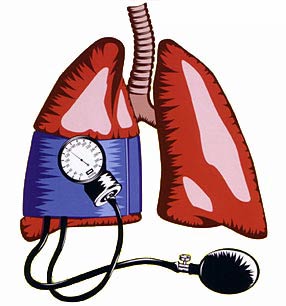Pulmonary hypertension is a medical condition where the blood flow that leaves the right side of the heart faces an increased pressure.
Normally blood flows from the right ventricle into the pulmonary arteries and then flows into smaller and smaller blood vessels until it reaches the capillaries. Oxygen is picked up and carbon dioxide is released. The blood vessels have muscles in their walls that can regulate their diameter and allow more or less blood flow to enter the capillaries.
In pulmonary hypertension, the blood vessels of the lungs have more muscle in the walls. This causes a higher pressure in the lungs. The right ventricle then has to work harder to pump blood out to the lungs. The right ventricle then gets larger and becomes thicker in response to the extra work. With time, the load placed on the right side of the heart can cause it to fail.
The long-term prognosis for pulmonary hypertension depends on the severity of the disease at the time of diagnosis and how well a patient responds to therapy. Recent advances in medical therapies have made great progress on the outcome of pulmonary hypertension.
Ask your doctor to explain pulmonary hypertension in greater detail.
